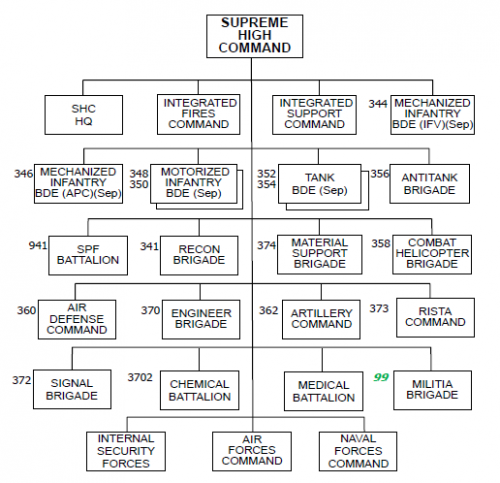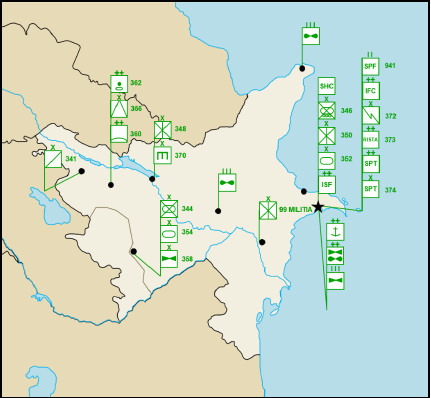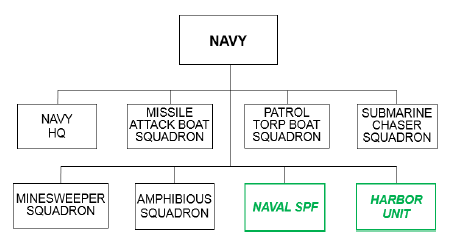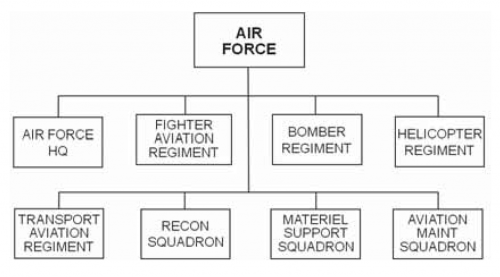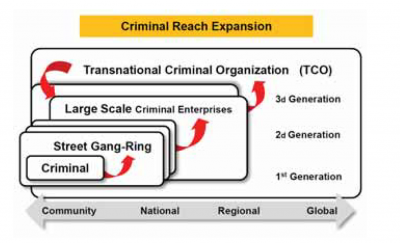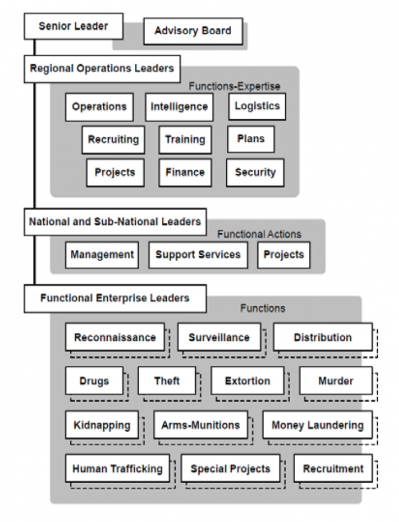Military: Atropia
Like most countries in the region, Atropia possesses a long history of regional irregular and regular warfare that shapes the country’s military attitudes. Donovia’s regional influence and over a century of ever-changing political boundaries never coincided satisfactorily with Atropia’s ethnic groupings. These unresolved issues contributed to the Atropian military’s current state. Atropia contains a majority Muslim population that remains less radical than the religious fundamentalists found in Ariana, but the possibility remains for Islamist attitudes to gain noteworthy influence over the military, with the potential for increased radicalization.
Contents
- 1 Military Forces
- 2 Military Strategy
- 3 Strategic Operational Framework
- 4 National Strategic Goals
- 5 Implementing National Security Goals
- 6 Military Forces Overview
- 7 Army Overview
- 8 Naval Forces Overview
- 9 Air Force Overview
- 10 Government Parliamentary Forces
- 11 Non-state Paramilitary Forces
- 12 Criminal Organizations
- 13 Private Security
- 14 Summary
Military Forces
The Atropian military consists of a small army, navy, and air force with limited offensive capabilities. The entire ground force roughly corresponds to the size of one US army corps, and the army dominates the Atropian military in terms of size and funding. The military generally uses equipment with technology 10 to 20 years old to make it a tier 2 fighting force. Due to the military’s small size, Atropia limits its scope to defending the country’s borders and regional operations, mostly directed against Limaria. The size of the Atropian military mirrors that of Limaria’s forces. Continual skirmishes with Limaria over disputed territory drive Atropia’s military doctrine, force structure, and deployment of forces. Like many of the countries in the region, Donovia’s doctrine and force structure influence Atropia. Unlike Limaria, however, hydrocarbon revenue allows Atropia to modernize its military.
Military Strategy
Atropian National Command Authority
All countries share a similar National Command Authority (NCA) construct including Gorgas, who refers to it as a National Council. Atropia’s NCA exercises overall control of the application of all instruments of national power to plan and carry out the national security strategy. The Atropian Army Chief of Staff, however, serves as the highest military individual in the chain of command over the military. The Atropian president serves as the commander in chief of the armed forces and functions at the top of the military hierarchy and decision-making process.
Strategic Operational Framework
The strategic operational framework for all countries in the region is similar in construct and application. This is primarily the result of historic influences transcending the region. The NCAs and the NC for all five countries exercise command and control (C2) of the Armed Forces via the Supreme High Command (SHC) that includes the Ministry of Defense (MOD) and a General Staff drawn from all the service components. In peacetime, the MOD and General Staff operate closely but separately. The MOD assumes the responsibility for Armed Forces policy, acquisitions, and financing. The General Staff promulgates policy and supervises the service components while its functional directorates assume responsibility for key aspects of defense planning. In wartime, the MOD and General Staff merge to form the SHC, which functions as a unified headquarters.
All five countries currently configure their militaries in an administrative force structure (AFS) that manages its military forces in peacetime. This AFS contains the aggregate of various military headquarters, facilities, and installations designed to man, train, and equip the forces. In peacetime, the various militaries group their forces into corps for administrative purposes. In some cases, the militaries may group their forces administratively under geographical commands designated as military regions or military districts. If the SHC elects to create more than one theater headquarters, it may allocate parts of the AFS structure to each of the theaters, normally along geographic lines. Typically, these administrative groupings differ from the country’s go-to-war (fighting) force structure. Other parts of the administrative force structure consist of assets centrally controlled at the national level. (See FM 7-100.4 Opposing Force Organization Guide: Chapter 3, Task Organizing.)
National Strategic Goals
The NCA determines the direction and scope of Atropia’s strategic mission. Atropia’s overall goals include the defense of its hydrocarbon resources, the eventual recovery of its Lower Janga region, and defense against any regional attacks by potential enemies. Atropia may possess one or more specific goals, each based on a particular threat or opportunity. Examples of specific strategic goals include:
- Resolution of territorial disputes, especially those with Limaria
- Defense of Atropia’s sovereignty and hydrocarbon resources
- Economic expansion
- Destruction of insurgent groups, especially those in the Lower Janga region
Implementing National Security Goals
All five countries share similar strategies to achieve their national goals. Strategic operations for all five countries remain a continuous process not limited to wartime or preparation for war. Once war begins, strategic operations continue during regional, transition, and adaptive operations and complement those operations. Each of the latter three types of operations occurs only during war and only under certain conditions. Transition operations can overlap regional and adaptive operations.
In pursuit of their national security strategy, all four countries find themselves prepared to conduct four basic types of strategic-level courses of action. The four types of operations include:
- Strategic operations use all instruments of power in peace and war to achieve a country’s national security strategy goals through attacks against the enemy’s strategic centers of gravity.
- Regional operations include conventional, force-on-force military operations against overmatched opponents, such as regional adversaries and internal threats.
- Transition operations bridge the gap between regional and adaptive operations and contain some elements of both. The country continues to pursue its regional goals while dealing with developing outside intervention that has the potential to overmatch its military.
- Adaptive operations preserve the country’s power and apply it in adaptive ways against opponents that overmatch the country’s military.
Implementing National Security Goals
All five countries share similar strategies to achieve their national goals. Strategic operations for all five countries remain a continuous process not limited to wartime or preparation for war. Once war begins, strategic operations continue during regional, transition, and adaptive operations and complement those operations. Each of the latter three types of operations occurs only during war and only under certain conditions. Transition operations can overlap regional and adaptive operations.
In pursuit of their national security strategy, all four countries find themselves prepared to conduct four basic types of strategic-level courses of action. The four types of operations include:
- Strategic operations use all instruments of power in peace and war to achieve a country’s national security strategy goals through attacks against the enemy’s strategic centers of gravity.
- Regional operations include conventional, force-on-force military operations against overmatched opponents, such as regional adversaries and internal threats.
- Transition operations bridge the gap between regional and adaptive operations and contain some elements of both. The country continues to pursue its regional goals while dealing with developing outside intervention that has the potential to overmatch its military.
- Adaptive operations preserve the country’s power and apply it in adaptive ways against opponents that overmatch the country’s military.
National Security Strategy
Although Donovia, Ariana, Atropia, Gorgas, and Limaria may refer to them as “operations,” each of these courses of action is actually a subcategory of strategy. Each type of operation aggregates the effects of tactical, operational, and strategic actions in conjunction with instruments of national power to achieve each country’s strategic goals. The types of operations employed at a given time will depend on the types of threats, opportunities, and other conditions present.
Each country’s strategy typically starts with actions directed at a regional opponent that the government overmatches in conventional military power, as well as other instruments of power. If possible, each government will attempt to achieve its ends without armed conflict. Accordingly, these governments do not limit strategic operations to military means and usually do not begin with armed conflict. They may achieve the desired goal through pressure applied by nonmilitary instruments of power, perhaps by merely threatening to use superior military power against the opponent. These actions fall under the general framework of “strategic operations.” The government may resort to armed conflict to achieve its desired end state when nonmilitary means prove insufficient or not expedient. Strategic operations, however, continue even if a particular regional threat or opportunity causes the country to undertake “regional operations” that may include military means. Prior to the initiation of hostilities and throughout the course of armed conflict with its regional opponent, the government will continue to conduct strategic operations to preclude intervention by outside players, other regional neighbors, or an extra-regional power that could overmatch its forces. Such operations, however, always include branches and sequels to deal with the possibility of intervention by an extra-regional power.
Military Forces Overview
Military Strategy
Atropian military strategy focuses on reclamation of lost territory from Limaria, and the two countries have an ongoing arms race. The Atropian military desires Ariana’s military support to seize such lost territory. To become more of a regional player, Atropia’s military continues to attempt to obtain more technologically-advanced equipment from other countries, primarily Donovia, Israel, and the US. Besides its design on lost territory, the Atropian military remains in mainly a defensive posture as it protects its oil and other key infrastructure.
Army Overview
Atropia maintains an army ground force, primarily composed of tank and mechanized forces and, due to equipment manufactured from technology 10 to 20 years old, the Atropian military fields a tier 2 fighting force. The size of the Atropian military keeps the force in a defensive posture and limits its actions to regional operations. The security of Atropia’s territorial integrity remains its military’s main objective. The Atropian military force intentionally mirrors Limaria’s military structure. Ongoing skirmishes with Limaria over disputed territory drive Atropia’s military doctrine, procurement, and disposition of forces. Donovian doctrine and force structure heavily influence the Atropian army. Lately, the army has enjoyed additional monetary resources due to government profits from hydrocarbon exports.
Army Size and Structure
The maneuver brigade serves as the Arianian, Atropian, and Gorgan militaries’ basic combined arms unit. In the AFS, some maneuver brigades find themselves constituent, or organic, to the base structure such as divisions, in which case the NCA refers to them as divisional brigades. These armies, however, organize some units as separate brigades, designed to possess greater ability to accomplish independent missions without further allocation of forces from a higher tactical-level headquarters. Separate brigades possess some subordinate units that contain the same force structure as a divisional brigade of the same type (for example, the headquarters); some units that are especially tailored to the needs of a separate brigade, marked “(Sep)” in the organizational directories; and some that are the same as units of this type found at division level, marked “(Div).” (See diagram on page 2B-2-3 and the Order of Battle (OB) at the end of this country’s variable.)
All five militaries design their maneuver brigades to serve as the basis to form a brigade tactical group (BTG) if necessary. A brigade, separate or as part of a BTG, can fight as part of a division, division tactical group (DTG), a separate unit in an operational-strategic command (OSC), an organization of the AFS (such as army, corps, or military district), or as part of a field group (FG). (See TC 7-100.2: Opposing Force Tactics, Chapter 2, Command and Control.)
The brigade serves as the Atropian army’s largest tactical organization. In peacetime, Atropia subordinates its brigades to a larger, operational-level administrative command. The Atropian army component headquarters may retain centralized control of certain elite elements of the ground forces, such as airborne and special purpose forces (SPF) units. This central control permits flexibility in the employment of these relatively scarce assets in response to national-level requirements. For these tactical-level organizations, the organizational directories contain standard table of organization and equipment (TO&E) structures. These administrative groupings normally differ from Atropia’s wartime force structure. (See TC 7-100.2: Opposing Force Tactics, Chapter 3, Offense.)
Atropia fields an army of approximately 68,400 personnel divided into one mechanized corps, two separate mechanized brigades, two tank brigades, and one motorized brigade. The Atropian army also contains various support and special purpose elements that include air defense, artillery, engineer, militia, SPF, and missile commands. Recently, the Atropian army established an information warfare brigade to develop electronic and computer warfare capabilities.
Army Doctrine and Tactics
The Atropian army gears its doctrine and tactics toward the opposition and the physical environment in which the army operates. The Atropian army can conduct large-scale operations with the ability to fluctuate between adaptive tactics and hybrid operations. The Atropians employ tactical control measures that include assembly areas, advance axes, check points, jump-off lines (similar to Western lines of departure), and attack lines. The Atropian army will likely engage its enemy to push back the opposition or buy time for mobilization of reserves, or the onset of adaptive warfare. (For more information on tactics, see TC 7-100.2: Opposing Force Tactics.)
Army Training and Readiness
The Atropian army faces a consistently high turnover rate since it uses conscription to fill its ranks for the active duty force, but the system creates a large civilian population with previous military experience. Most Atropian males must serve for 18 months on active duty, but university graduates only need to serve 12 months. Atropia contains no official reserve force, but over 560,000 civilian Atropians possess military experience from the past 15 years and could serve again, if necessary. Despite the constant turnover in the enlisted ranks, the Atropian army fields a well-trained force with a 94% readiness rate.
Army Equipment and Weapons
The Atropian army primarily uses tier 2 equipment and weapons or modern competitive military systems fielded from the last 10 to 20 years throughout its force structure. Due to the influx of funds from hydrocarbon exports, the Atropian army upgraded some of its systems so it now has some limited tier 1 niche capabilities. The Atropian army has the equipment to operate in all terrain types and can successfully conduct 24-hour operations. (For further information see Section 4: Appendix C or the Worldwide Equipment Guide (WEG): Vol. 1, Chapter 1, OPFOR Tier Tables.)
The Atropian navy patrols the Caspian Sea, its main responsibility, with a small and agile force. The Atropian navy also secures the country’s coastal waterways, conducts anti-smuggling operations, and protects the hydrocarbon infrastructure in the Caspian Sea.
The Atropian navy maintains its headquarters and operates its main facilities in the Atropian capital, Baku. Recently, the Atropian navy conducted Caspian Sea exercises that indicate it has improved equipment and training to at least a tier 2 rating level. (See the OB at the end of this country’s variable.)
Atropia maintains a naval force heavily influenced by Donovian naval doctrine. The navy may engage in hit-and-run tactics if attacked by larger Caspian Sea naval powers. At all times, the Naval Commander will attempt to preserve the capability to defend Baku and the off-shore hydrocarbon fields. Atropian naval missions include:
- Defensive patrolling of coastal areas
- Anti-smuggling operations
- Defensive mine laying
- Insertion/extraction of special operations forces
- Protection of isolated oil rig platforms
The Atropian navy possesses 39 surface craft with no submarines or major surface ships. It operates a variety of attack boats, patrol boats, submarine chasers, minesweepers, and amphibious squadrons. The Atropian navy also fields a small naval special operations forces (SOF) along with harbor salvage and clearance capabilities. (See diagram on previous page for more detail.)
Due to its small size and recent purchase of new equipment that reduce the likelihood of many maintenance problems, the Atropian navy operates a well-trained force at an overall 93% operational readiness rate.
The Atropian navy fields largely tier 2 equipment and weapons with limited tier 1 niche capabilities financed through hydrocarbon resources. Atropian naval equipment focuses on defensive operations, especially the defense of off-shore hydrocarbon infrastructure. Atropia will continue to purchase equipment (like mine countermeasure ships), increase SOF capabilities, and improve its amphibious forces. The Atropian navy can operate in all seas and can successfully conduct 24-hour operations.
Air Force Overview
The Atropian air force is small but could be deadly in a regional conflict and is best suited for defensive operations.
Air Force Size and Structure
The Atropian air force fields an estimated 8,000 personnel that operate approximately 110 fixed wing aircraft and 40 helicopters. The Atropian air force operates from military and civilian airfields all over the country, but the Baku metropolitan area contains the two largest military airports. The Atropian fighter aviation regiment is located in the Rimzi Airbase on the Hachzi peninsula. Smaller fixed wing and rotary wing elements can support ground troops in contested regions from any suitable runway. (See the OB at the end of this country’s variable.)
Air Force Doctrine and Tactics
The Atropian air force’s missions include protection of the country’s borders, troop transport, close air support for ground forces, and protection of key infrastructure such as political and economic targets. Atropian pilots possess a respectable reputation for their flying skills with the ability to conduct deep strikes. Despite the heavy Donovian influence on the Atropian air force doctrine and tactics, the Atropians can adapt to a changed environment. Recent operations and training with Western air forces exposed the Atropians to non-Donovian ideas about flexible and adaptive operations.
Air Force Training and Readiness
Due to its small size and ability to increase its flight hours because of a greater operational budget, the Atropian air force maintains a high level of training and a 94% operational readiness rate.
Air Force Equipment and Weapons
The Atropian air force operates equipment and weapons based on technology from 10 to 20 years ago to create a tier 2 capability rate. The infusion of funds from high hydrocarbon export revenues allowed Atropia to upgrade some air force systems for selected tier 1 niche capabilities. The Atropian air force can conduct 24-hour operations in all weather and over all terrain. (For further information see the OB at the end of this country’s variable and the WEG, Vol. 2: Airspace and Air Defense Systems.)
Government Parliamentary Forces
The Atropian government tasks the Atropian national police, a paramilitary force, with the following missions: basic law enforcement, border control, and maintenance of public order such as riot control. Besides the national police, which operate under the Interior Ministry, additional paramilitary forces work for the Ministry of Intelligence. The total number of Atropian paramilitary forces is around 65,000 personnel. In a conflict, the Atropian paramilitary organizations will likely provide presidential security and protect critical infrastructure. The Atropian military will probably use these paramilitary organizations' reserve elements in its national defense plans.
Non-state Paramilitary Forces
Insurgent/Guerrilla Forces
While numerous reasons exist for internal conflict in Atropia, two main reasons stand out above all others—ethnocentrism (separatist movement) and nationalism. This internal strife devolved to irregular warfare as state and nonstate actors struggled to gain legitimacy and influence over the populace. Sporadic violence over the last decade targeted government entities and key leaders. Several foreign-supported anti-Atropian insurgent groups operate within Atropian territory. The two dominant groups in the area of operations are Salasyl and the South Atropian Peoples’ Army (SAPA).
Salasyl is one of the largest groups within Atropia, second only in size to SAPA. Its center of gravity is in the southeast portion of the country, but the group is fully capable of conducting operations throughout the country, and in reality does so. It is also reported that the group may have ties to transnational criminal and terrorist actors. The extent and dynamic of the relationship between Salasyl and these transnational actors is unknown at this time. For the last two decades, Salasyl has engaged the current Atropian regime in a low-level insurgency. Salasyl encourages the local populace to violently oppose the legitimate Atropian government due to state taxation policies; lack of reliable public services such as electrical power, sewage treatment, and potable water; substandard preventive medical services; lack of access to state education programs for working class citizens; and a state judicial system that illegally favors the political party currently in control of the government’s executive and legislative branches.
SAPA, the other major insurgent group, relates culturally to Ariana and wants to create a separate country composed of southern Atropia and Ariana’s northwestern provinces that contain an ethnic Atropian majority. The SAPA feels that the South Atropian People’s Party (SAPP) carries little weight in the Atropian political system, and reforms to assist the local people show few signs of progress. The SAPA, while it operates throughout Atropia, focuses on eight provinces in the south due to cultural ties with Ariana. The SAPA operates in three separate major units—Northern, Central, and Southern Commands. The group conducts most of its training in Ariana, where it receives most of its equipment and supplies. Reports indicate that Arianian SPF or other “advisors” may support the SAPA with logistics and training in the country. The Salasyl insurgents often clash violently with the SAPA over ideology, limited resources, and similar recruiting pools.
Two smaller insurgent groups that operate in northern Atropia are the Bilasuvar Freedom Brigade (BFB) and the Provisional Army of Lezgin (PAL). Donovia supports the BFB, which creates political tension between Donovia and Atropia. Other groups and affiliates in Atropia find themselves sympathetic to pro-Western economic initiatives and social-political concepts of state governance. Coalition forces will need to not only determine each domestic group’s agenda, but also discern whether they are criminal organizations, private militia, insurgents, or guerrillas to determine whether the groups will be useful to meet coalition objectives.
At least three forms of armed and unarmed combatants will emerge from these domestic groups if the US or coalition forces deploy to the region. First, factions currently opposed to the Atropian government and not friendly toward the US-led coalition presence will initiate overt resistance. They will initiate violent and nonviolent protests against both the Atropian government and the US-led coalition because they consider the outsiders to be an extension of the current Atropian regime. Second, factions currently against the Atropian governmental policies, but potentially friendly toward the US-led coalition, will support the outside military intervention in hopes that the current Atropian government will fall or at least change its policies toward their group. Third, several extremist anti-Western factions will quickly resort to expanded terrorism if a US-led coalition enters Atropia, as they do not want any Western inference. These anti-Western groups will target US/coalition forces, logistical staging points, and Atropian law enforcement and internal security forces. Foreign entities may influence any of these three domestic factions with money, materiel, or training to elevate civil unrest as long as it helps accomplish the outside group’s long-term goals.
Criminal Organizations
Organized crime and its interrelationships in irregular warfare are active throughout the region. Crime is widespread and mostly linked to historical traditions and ancestral allegiances. Distinguishing crime as distinct from ongoing ethnic feuds, ideological and theological extremism, or elements of the society that incite insurgency for particular political expectations is problematic at best. At its worst, this category of violence is enmeshed in the daily lives of most people whether they reside in urban centers or are part of a rural ecosystem.
The region contains criminal organizations such as the Bocyowicz Crime Family, the Atropian Organized Crime (AOC) group, and the Al Iksir Cartel, some of which have developed into sophisticated transnational criminal organizations (TCO) with ambitious economic and political agendas. The AOC operates primarily in Baku while the Al Iksir Cartel operates in northern Atropia and southern Donovia. The Bocyowicz Crime Family is a third- generation criminal organization with the ability to control ungoverned territory within nation- states, acquire political power in poorly-governed regions, and eventually vie for geographic controlled space. These political actions are intended to provide security and freedom of movement for the criminal organization’s activities. As a result, the third- generation criminal organization and its leadership challenge the legitimate state authority on exercise of political control and use of criminal violence within a given geographical area.
Private Security
Organizations
Some of the foreign companies that help operate the Atropian oil and gas industry hire private security guards to protect the infrastructure.
Nonmilitary Armed Combatants
The insurgent and guerrilla forces operating in Atropia are openly hostile to US involvement in the region. The criminal organizations are predominantly neutral in their view of the US as long as the criminals’ economic interests are not compromised. For the most part, the private security organizations that protect the Atropian oil and gas infrastructure are predominately neutral to somewhat friendly, since some of them work for foreign companies.
RISTA
The Atropian military views reconnaissance, intelligence, surveillance, and target acquisition (RISTA) as the single-most important function for the Atropian military, because it sets the stage for all other military operations. Atropian military forces tend to commit significant resources to RISTA- related operations with aggressive overlapping redundancy in the intelligence disciplines. The table below summarizes the range capabilities of the reconnaissance assets that support Atropia’s tactical commanders.
Fire Support
During past conflicts, Atropia’s military has successfully integrated fire support into operations, from close to deep-strike capability. The commanders always seek to increase the effectiveness of air and missile strikes and artillery fire to destroy enemy formations, weapons systems, or key components of an enemy combat system. (See TC 7-100.2: Opposing Force Tactics, Chapter 9, Indirect Fire Support.)
Protection
Atropia will attempt to minimize civilian casualties to a large extent. The military has engineering assets to reinforce civilian and military positions. The C2 and fire support systems are sophisticated enough to minimize the threat of “friendly fire” or other accidents. The military and civilian populations are closely integrated, however, making it difficult for invaders to launch attacks without the risk of civilian casualties, which would enrage the population and be used as ammunition for INFOWAR. (See TC 7-100.2: Opposing Force Tactics, Chapter 12, Engineer Support and Chapter 7, Information Warfare.)
Logistics
The Atropian military possesses robust logistics capabilities with the ability to support its maneuver units for any length of time. All five countries continue to improve in all aspects of their logistics systems, with Atropia doing so through the influx of funds from hydrocarbon resources. These improvements include an increased emphasis on support zone security and plans to stockpile war materiel throughout each country.
Chemical, Biological, Radiological, and Nuclear
Should the strategic need arise, Atropia could produce CBRN munitions, weapons, and/or components from its own resources. It has long been suspected, but not proven, that Atropia may possess very limited CBRN munitions. Atropian strategic policy does not support a CBRN first strike. Its contingency plans for the acquisition of CBRN, when needed, are primarily for the defense of Atropia’s sovereignty. In the event of an impending CBRN strike against the Atropian homeland, however, it could decide to use preemptive CBRN strikes. Should any opponent conduct a CBRN attack against Atropia, it may retaliate in kind. Atropia has a wide variety of CBRN delivery means organic to its military forces. It has surface-to- surface missiles capable of carrying CBRN warheads. Most Atropian artillery is capable of delivering chemical munitions, and most systems that are 152-mm or larger are capable of firing nuclear rounds. Additionally, Atropia could use aircraft to deliver a CBRN attack. Trained Atropian SPF may also be used as alternate means of delivering CBRN munitions packages. Atropia is also well- prepared to employ CBRN protection measures—civilian and military—and has chemical defense units organic to all maneuver brigades.
Atropia has a substantial industrial base that produces large quantities of toxic industrial chemicals (TIC), which are chemical substances possessing acute toxicity. An adjunct to chemical weapons is use of TIC, which can easily be exploited as improvised (or converted into) chemical weapons by military and civilians alike. (For a listing of possible high- and moderate-risk TIC possibly available to Atropia see the WEG, Volume I, Chapter 14, Improvised Military Systems.) For additional information on the capabilities, release authority (NCA), and employment of CBRN, see TC 7-100.2: Opposing Force Tactics, Chapter 13, CBRN and Smoke. For specific technical information, delivery means, agents, and effects of CBRN, see the WEG, Volume I, Chapter 11, Chemical, Biological, Radiological, and Nuclear (CBRN).
Research & Development Goals
Atropia will continue to purchase its military equipment and arms from outsiders, especially the West. If oil and natural gas prices remain high, however, the Atropian military industrial complex may begin to flourish as government revenues slowly stream into military research and development (R&D). Atropia will likely focus its R&D efforts on INFOWAR or other capabilities that can level the playing field between Atropia and its larger neighbors. In 2013, Atropia announced goals to begin R&D into its own space program. Details are not known at this time, but it is assessed that Atropia is developing a space program to support economic and commercial interests. However, technologies that are dual-use indicate that these satellites could ultimately assist in military operations.
Special Considerations
Atropia’s military policy focuses on its relationship with Limaria over the Lower Janga region. Atropia wants to regain the Lower Janga region, but will reluctantly settle for the current status quo. Atropia also wishes to maintain sufficient power to deter military action from Donovia or Ariana, or at least delay its attackers until it can receive Western assistance from the US and its allies. Atropians recognize their inability to sustain a successful defense against Donovia or Ariana. Out of self-interest, Kalaria or Gorgas will most likely support Atropian defense against any foreign attacker.
Summary
Atropia maintains a small but capable military that consist of ground, air, and naval forces. Its size almost mirrors that of the Limarian military except that Atropia maintains naval forces due to its location on the Caspian Sea while Limaria, as a land-locked country, fields no naval forces. Due to its hydrocarbon resources, Atropia is an important country for the Western world and the protection of its oil and gas infrastructure is a prime consideration for any military operation in the Caucasus region. Atropia’s long-simmering antagonism against Limaria remains in the forefront of the Atropian military in all of its operations.


